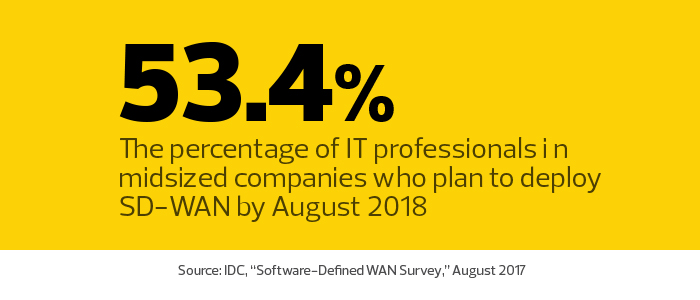SD-WAN: The Just-Right Network Technology for Many Small Businesses
Last year, Briggs & Stratton rolled out Cisco Systems’ Intelligent WAN to 45 sites scattered around the world.
The software-defined IWAN lets the company deliver more functionality to remote locations for the same or lower cost than was previously possible.
“We’re a global company and need the most secure, reliable and cost-effective way to distribute information and resources we can find,” IT Director Norm Mackensen says. “With IWAN, we have increased visibility into the network and added security without adding cost. And because Cisco is also an industry standard, our management partners all over the world are familiar with its technology.”
Milwaukee-based Briggs & Stratton is the world’s largest producer of gasoline engines for outdoor power equipment, as well as a leading designer and manufacturer of, among other products, lawn and garden and job site equipment.
While global enterprises like Briggs & Stratton have quickly adopted SD-WANs, the technology can benefit small and medium-sized businesses as well, says Brad Casemore, an IDC research director.
“If an SMB has a number of remote branches that are critical to the success of the business, runs critical applications and services at those remote sites, and has a need to tap into a more cost-efficient way to access bandwidth, there’s a compelling case for SD-WAN,” Casemore explains.
SMBs whose operations are geographically distributed will save money while delivering critical apps — especially real-time apps — more reliably and simplifying IT management, he says.
“If you do SD-WAN right, you can take IT out of all your branches and provision and manage all your resources centrally,” Casemore says. “Adopting SD-WAN is becoming easier as vendors develop turnkey solutions and providers begin to offer SD-WAN as a managed service.”
SIGN UP: Get more news from the BizTech newsletter in your inbox every two weeks!
SD-WAN Increases Network Agility
At Briggs & Stratton, improved security and more efficient use of network resources were drivers of the move to SD-WAN, says Mark Ciszek, the company’s IT platform manager for infrastructure.

IWAN has enabled end-to-end encryption for the network, while providing increased visibility and real-time control over network traffic, he says. Among the results, Ciszek points to improved reliability, streamlined network auditing processes, reduced provisioning time and lower integration costs for new applications.
“The SD-WAN has definitely made us more agile, which is great not only for daily operations, but also in a mergers and acquisitions context and as we integrate into cloud services,” he says.
Briggs & Stratton partnered with CDW for the design and deployment of the SD-WAN. The new setup integrated and rationalized the company’s existing WAN scheme, which consisted of internet plus multiprotocol label switching (MPLS) with VPN backup. By installing the IWAN, Briggs & Stratton was able to make more efficient use of all its connections, says CDW Technical Architect Will Kerr.
“It allows Briggs & Stratton to go to active-active connections, instead of active-backup, which increases bandwidth and reduces reliance on expensive MPLS,” Kerr says.
For Mackensen, SD-WAN is a technology that helps prepare Briggs & Stratton for the future. “This is one of the ways that gives our company the flexibility to leverage our partners and new systems as we continue to grow,” he says.
A Steady Rollout of SD-WAN at Branch Locations
On a much smaller scale, the Salon Service Group in Springfield, Mo., had the same needs as Briggs & Stratton.
By spring 2017, the professional hair products distributor was supporting 30 stores in 11 states and needed a way to integrate its increasingly complicated network, says Chris Rushton, SSG project director.
A staged rollout of a cloud-delivered SD-WAN completed last fall has resulted in more control, visibility and security for the SSG network, along with cost savings, she says.
“We were dealing with long-distance calling to stores, billing from many carrier sources, and data that was insecure, incomplete and that we had no control over,” Rushton says. “Since we’ve started using VeloCloud, billing is under control. I can now log in to all locations and see and manage that part of the network.”
SSG approached the rollout of VeloCloud (acquired by VMware in November 2017) cautiously, purchasing an appliance for one location as a trial. After the technology passed initial tests, the company deployed the SD-WAN store by store until the entire network was connected.
“The hardest part of the deployment was understanding what was already in each location — the cabling, the carriers, the various technologies,” Rushton says. “Once that was done, VeloCloud was easy to install, and we started getting security and visibility benefits, along with cost savings.”
So far, the move has been without hiccups. And the ability of the SD-WAN service to control network traffic has eliminated downtime.
“We haven’t seen any downsides to it yet,” Rushton says.
Move to a Modern, Flexible Network Architecture
Moving away from a network that was aging and not able to support growth was what made IMMI a “poster child” for SD-WAN, says Tom Braden, vice president of enterprise technology for the manufacturer of vehicle safety products.

Based in Westfield, Ind., with a branch in Texas and five international locations, IMMI needed a technology that could accommodate the complexity of its network, which includes MPLS and 4G, along with dual internet connections to all locations.
“The routers and firewalls and VPNs we had relied on to connect our locations securely for close to a decade were becoming unsustainable,” Braden says. “We had a connection, but no control over traffic; a guest on a plant Wi-Fi network had the same bandwidth priority as our enterprise resource planning system.”
SD-WAN Enables Granular Traffic Management
The company opted to move to a Silver Peak SD-WAN because, he says, “it gave us the power to shape all that network traffic.” Through the Silver Peak graphical user interface, the IT team in Indiana can aggregate traffic or designate backup and failover protocols for any location.
“The SD-WAN gives a level of simplicity and granular control that we’ve never had before,” Braden says. “And it’s so easy to configure and use that I can train an intern on the GUI.”
IMMI has had the Silver Peak SD-WAN running at all its sites since November, and the benefits are already apparent. Deployment time for apps has been cut, Silver Peak’s Forward Error Correction has eliminated packet loss, latency has been reduced and, most important, Braden says, network reliability has been optimized.
“It’s part of my job to pick technologies with legs, ones that are still going to have essential value in five years or more,” Braden says. “SD-WAN is one of those.”
SMBs that want to migrate to SD-WAN could have an advantage over large enterprises, says Chris Burger, a CDW senior consulting engineer who worked on the Briggs & Stratton deployment.
“Their networks are less complicated, which cuts down on deployment issues,” he says. “Smaller companies seem to be able to make the transition to SD-WAN more quickly, so they get the advantages of the technology more quickly.”







